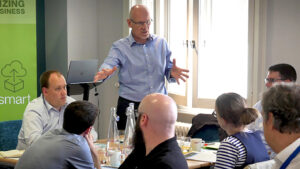Digital Dedication: How governments can go digital
Last week we got together with our partner Alfresco and customer the Department for Business, Innovation and Skills to discuss digital dedication at the BIS Conference Centre in Westminster.
What’s that, you ask? It’s quite simple, really. We all recognise the potential for digital solutions to reform the public sector, leading to better services across the board. Everyone stands to benefit from the creation of digital government: citizens, ministers, civil servants and the many thousands in government jobs around the UK.
But Rome wasn’t built in a day.
Embed digital technologies
Indeed, it takes time to embed digital technologies into the very DNA of government. It requires a much larger programme of change, from communications and culture through to business processes and work flows.
Once our chief executive Stephen McLoughlin had kicked us off, we heard from three truly expert speakers on not only why government needs to go digital, but how best to actually do it.
To quote John Newton, CEO of Alfresco, “we’re in the midst of a digital renaissance.” But unlike the first renaissance, this time Britain cannot afford to get left behind. To compete in the 21st Century economies must take advantage of the huge advances made in four areas of tech: cloud, social, mobile and big data.
And that’s not all. To really drive organisational change, organisations need to think differently – to become more like APIs and encourage an ecosystem of innovation with themselves at the centre.
Department for Business, Innovation and Skills
Of course this is no mean feat. But BIS is leading the way, and worked with us to implement Alfresco – providing a better platform on which to do business, across the organisation. Julia Harwood, the department’s CIO and DSO summed up the challenge of change perfectly: “it takes dedication – and longer than you think!”
How did BIS do it? Our founder and CTO Aingaran Pillai says first things first – own the user experience. It’s no use building in lots of new features if the end user can’t make sense of the solution.
After that, keep one key principle in mind: agility. Develop a workable solution and run with it early, iterating to improve it as you find out what is and isn’t working. Open source platforms allow organisations to constantly customise, tweaking solutions until they match their unique and specific needs. Even better, open standards and APIs allow us to swap out technologies that don’t quite fit and replace them with something better.
But what’s the biggest challenge? Culture change – it’s a seismic shift.
It doesn’t matter how good the UX is if people aren’t encouraged to use it. And it takes a lot to move employees onto a new system. As Julia said, “user engagement is a process, not an event.” BIS took a number of approaches to get staff engaged and up to speed, from informal “search with a sandwich” sessions to online tutorials – and all sorts in between.
Once this is done, there’s no time to rest on your laurels. This was an event on digital dedication, after all. During our closing panel session, Howard Orme, Director General, Finance and Commercial at BIS made the killer point: “Don’t think it ends once the project’s been implemented. The tech world moves so quickly – you’re only ever halfway there.”
Great to hear about the 'digital renaissance' from @johnnewton, govt must be digital first #digibis15 pic.twitter.com/C4fzfS1Nnn
— Alex Swanson (@alswanson) December 3, 2015
We have a full house at the #DigitalDedication event #DigiBIS15 @Alfresco @bisgovuk pic.twitter.com/SJjay37Taa
— Zaizi (@Zaizi) December 3, 2015
What does Digital mean to @bisgovuk @Alfresco pic.twitter.com/ioVNui1g20
— Zaizi (@Zaizi) December 3, 2015
Excellent panel for the panel discussions now at #DigiBIS15 @Zaizi @Alfresco @bisgovuk pic.twitter.com/93c3M5Y398
— Zaizi (@Zaizi) December 3, 2015
Related content
-

Meetup: Data-driven government
Published on: 1 June, 2016 -
Alfresco meetups for government | Follow up
Published on: 5 February, 2016 -
Secure Collaboration in Government
Published on: 14 January, 2016 -
Department for Business Innovation & Skills Selects Zaizi’s Alfresco Collaboration and Records Management service on G-Cloud
Published on: 30 November, 2013
